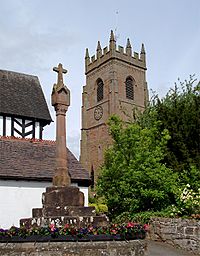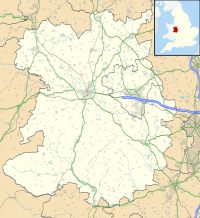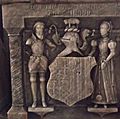All Saints Church, Claverley facts for kids
Quick facts for kids All Saints Church, Claverley |
|
|---|---|

Tower of All Saints Church, Claverley,
and churchyard cross |
|
| 52°32′18″N 2°18′26″W / 52.5383°N 2.3072°W | |
| OS grid reference | SO 793 934 |
| Location | Claverley, Shropshire |
| Country | England |
| Denomination | Anglican |
| History | |
| Status | Parish church |
| Founder(s) | Roger de Montgomerie |
| Architecture | |
| Functional status | Active |
| Heritage designation | Grade I |
| Designated | 9 March 1970 |
| Architect(s) | W. Wood Bethell (rebuilding of tower) |
| Architectural type | Church |
| Style | Norman, Gothic |
| Specifications | |
| Materials | Sandstone |
| Administration | |
| Parish | Claverley |
| Deanery | Bridgnorth |
| Archdeaconry | Ludlow |
| Diocese | Hereford |
| Province | Canterbury |
All Saints Church is located in the small village of Claverley, in Shropshire, England. It's an active church for the Anglican faith, serving as a local parish church. It shares its church duties with Holy Innocents, Tuck Hill. This church is very important, listed as a Grade I building. This means it's a special historic place that needs to be protected.
Contents
History of All Saints Church
This church has a very long history, going all the way back to the 600s! The church you see today was started by Roger de Montgomerie, 1st Earl of Shrewsbury, a powerful earl who passed away in 1094.
Around the late 1400s, the church tower was made twice as tall. Strong supports called buttresses were added to it at the same time. Also, a new chapel was built on the north side of the church. In 1902, the top two parts of the tower were rebuilt. W. Wood Bethell made sure to copy the original design perfectly.
Church Design and Features
Outside the Church
All Saints Church is built from local red sandstone. It has a main area called a nave with high windows, and side sections called aisles. There's also a chancel, which is the part of the church where the altar is. This chancel has two chapels next to it, one on the north and one on the south.
In the middle of the church's south side is a tall, four-part tower. To the west of the tower is a two-story entrance porch. The south chapel is located to the east of the tower. On the south side of the tower, you can see a round-headed window from the Norman period.
The chancel, with its large east window, shows a style called Decorated. The south chapel is in the Perpendicular style. The north chapel has windows from both the Decorated and Perpendicular styles. This north chapel is now used as a vestry, which is a room for clergy and choir robes.
The windows in the north aisle and the large west window of the nave are Decorated. You'll find Perpendicular windows in the south aisle, in the high windows of the clerestory, and at the west end of the north aisle. The south porch and the north doorway are also in the Perpendicular style.
Inside the Church
The north arcade, which is a row of arches, mostly dates back to the early 1100s. These are Norman arches, which are round. They rest on circular piers (columns) with round tops called capitals. The arch leading to the north tower is from the late Norman period.
A support added to the tower in the 1400s sticks out inside the church. It forms a round-headed space called a niche. This spot is known as the 'seat of penitence'. Another set of arches to the west of the tower was built in the mid-1200s. These arches are supported by eight-sided columns. The tops of these columns are carved with faces, leaves, and even two dragons nibbling a human head!
The arch leading to the chancel and the two arches into the north chapel are Decorated in style. The arch into the south chapel is Perpendicular. The roof of the nave is also Perpendicular, while the chancel has a special type of roof called a hammerbeam roof.
The church has two fonts. One is Norman, shaped like a tub, and carved with arches. The other is round and might also be Norman. The pulpit, where sermons are given, is from the Jacobean period. It's carved with flower shapes under arches. The altar rail, which separates the altar from the rest of the church, was made around 1912. It's in the Arts and Crafts style and was created by F. Waldo Guy. He was the brother of the church's vicar at that time.
In the west arch of the north chapel, you can see the lower part of a screen from the late Middle Ages. The walls of the nave have paintings from around 1200. These include a long band of fighting knights. Below this, there's a painting showing the death of Saint Margaret of Antioch. Between the high windows of the clerestory, there are paintings from the 1400s. These show saints or apostles.
Stained Glass Windows
The stained glass in the east window was made in 1858 by Frederick Preedy. It shows scenes from the Te Deum, a Christian hymn. In the north wall of the north chapel, which is now a vestry, there's 16th-century glass that has been put back together. It includes a woman's head, an angel, and vines.
The window in the east of the south chapel, from about 1849, was made by David Evans. It's based on Raphael's famous painting, Transfiguration. There are two windows by Hardman. One is in the tower and shows Doubting Thomas. The other is in the north aisle. In the north chapel, there's a window from 1879 by W. G. Taylor showing the Good Shepherd. You can also find two Arts and Crafts style windows from the 1930s by A. J. Davies.
Monuments and Memorials
The oldest monument in the church is a carved stone slab for Richard Spicer, who died in 1448, and his wife. There's also a large monument to Sir Robert Broke, who passed away in 1558, and his two wives. This monument is made of alabaster and shows three figures lying down on a tomb. Children are shown standing around the sides.
In the south chapel, you'll find two more carved stone slabs. One is for William Gatacre, who died in 1577, and the other for Francis Gatacre, who died in 1599. Also kept here is a special battlefield marker cross. It came from the grave in France of Captain E.G. Gatacre, who was killed in World War I in 1916.
The church's war memorial is made of sandstone panels with carved arches. It's located at the west end of the church. It first honored 30 men who died in World War I. Later, names from World War II were added. The south porch has another set of stone panels. These list all the men from the village who served in World War I. Stars next to some names show that 42 men were wounded. This porch memorial was built into the wall by Stephen Pickerell and engraved by James Summerell between 1921 and 1922. It has a very long inscription, said to be the longest on a war memorial in Shropshire.
Music and Bells
The church has a pipe organ with two keyboards. It was built in 1906 by J. W. Walker and rebuilt in 1964 by W. Hawkins. There is also a ring of eight bells. The two oldest bells were made in 1703 by Abraham Rudhall I. Another bell was cast by Thomas Rudhall in 1769. One bell from 1877 was made by John Taylor and Company. The last four bells were cast in 1929 by Gillett and Johnston.
Outside the Church Grounds
Around the church, there are three other important structures. At the entrance to the churchyard, there's a 14th-century cross. It stands on a base with three steps. This cross used to be in the road before it was moved into the churchyard.
The lychgate, which is a covered gateway to the churchyard, probably dates from the 1800s. It's made of brick with a tiled roof and looks like it has fake timber framing. The walls on the east side of the churchyard and the gate pillars, with their pointed tops, are likely from the 1700s. In the churchyard, there's a yew tree that is said to be 2,500 years old! There is also a war grave for an airman who died in World War II.
Past Events
For about 45 years, the church used to hold a wonderful Flower Festival every July. However, fewer visitors came during the 2010s. The COVID pandemic meant the event couldn't happen for two years. Many volunteers were also lost, so the flower festival has not been brought back.
See also
- Grade I listed churches in Shropshire
- Listed buildings in Claverley
Images for kids
-
Tombstone of Francis Gatacre (died 1599) and Elizabeth Swynnerton, daughter of Humphrey Swynnerton. The stone is now mounted on a wall in the south chapel of All Saints church.
-
Chest tomb of Robert Broke, Speaker of the House of Commons in 1554, and his wives: Anne Waring and Dorothy Gatacre, daughter of William Gatacre.
















